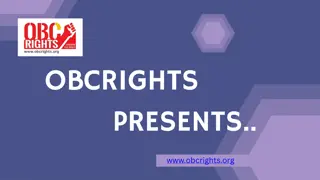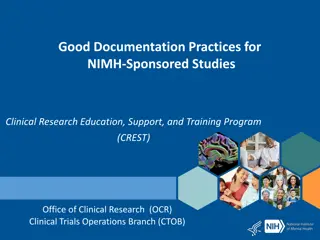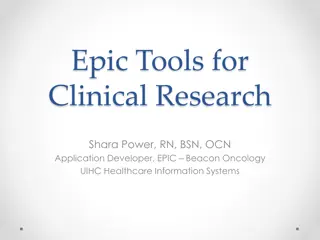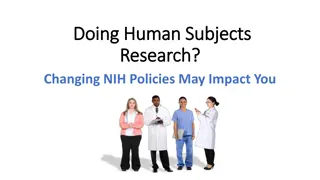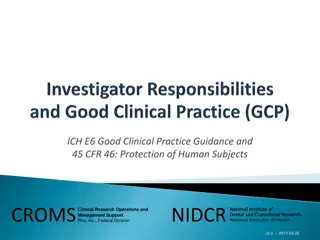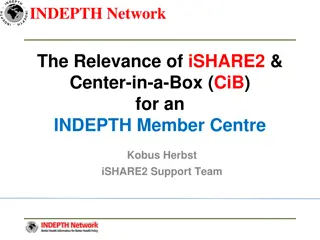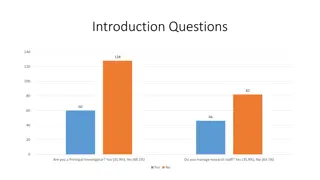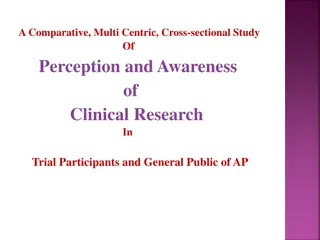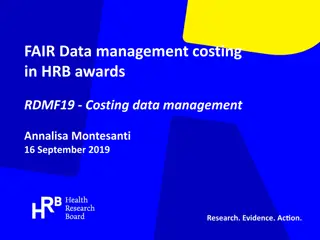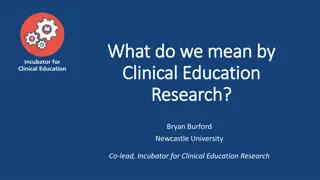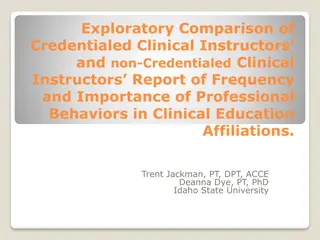Importance of Good Data Management Practices in Clinical Research
Learn about Good Data Management Practice (GCDMP), Good Documentation Practice, and Good Storage & Archiving Practice in clinical research. Understand the significance of data, key data collection processes, best practices for reporting data in CRF, importance of documentation, and data storage/archiving methods. Explore why proper clinical data management is crucial for research integrity and how bad data management can have profound consequences on public perception of scientific results.
Download Presentation

Please find below an Image/Link to download the presentation.
The content on the website is provided AS IS for your information and personal use only. It may not be sold, licensed, or shared on other websites without obtaining consent from the author. Download presentation by click this link. If you encounter any issues during the download, it is possible that the publisher has removed the file from their server.
E N D
Presentation Transcript
An Introduction to: Good Data Management Practice (GCDMP), Good Documentation Practice & Good Storage / Archiving Practice
Acknowledgment Acknowledgment to Ms Teo Jau Shya and Chun Geok Ying for preparation of the core contents of this presentation.
Objective Know what are data Understand the importance of data management Be able to understand key data and process of collecting the data Know best practice of reporting data in CRF Awareness of Good documentation practice Understand how to store and archive data and the related research documents
Good Clinical Data Management Practice -why is it important? Data are the most important product of clinical research = oxygen in science The ability to record, store, manipulate, analyze, and retrieve data is critical to the research process To provide consistent, accurate & valid data To support the accuracy of the final conclusion & report
Consequences of bad data management A small amount of data errors, even if the effect is minimal on scientific conclusions, the effect of discovered errors in the data on public perception & external acceptance of the results can be profound. Example: In 2006, Japanese researchers technique for creating cells that have the embryonic ability to turn into almost any cell type in the mammalian body the now-famous induced pluripotent stem (iPS) cells. reported1 a
HEADLINES RIKEN president Ryoji Noyori bows during a press conference in Tokyo, where investigators revealed the results of their investigation into Haruko Obokata's research. Public misled by distorted results into drawing conclusion
DATA SEQUENCE Case report form design Database design Protocol Design Data cleaning, verification and dataset locked Data entry Data collection Statistical analysis Report writing publication
Data Collection Tool - Case report form (CRF) Data from a clinical research is collected in a CRF.
Development of a Data management strategy Purpose: to turn Data into knowledge translate relevant activities within protocol into data Planning stage-How to design data collection tool/CRF: Identify data sources Primary or Secondary sources? Clearly define all data to be collected before seeing first subject Data field clearly define and consistent throughout including base units Ie: Blood pressure: Systolic BP (mmHg) + Diastolic BP (mmHg); Height (cm) Store raw data fields: ie: Ht and Wt instead of BMI Identify a list of possible confounders: to adjust for final data analysis Identify data collection strategy: data structured? Data is available from patient s records? Need to interview subjects?
Development of a Data management strategy Planning stage (continue) Using questionnaire to collect data: Validated-in English and local language? Any licensing issue? If outcome measures (ie: Size of tumour) is derived from X-ray, ECG: identify means to store those high density data Finalized data collection tool state version number and effective date Quantitative studies: reduce free-form text data (ie: narrative): difficult to analyse Quantitative studies: unstructured data, transcribe into text: how to capture data? Recording? Video taping? Identify who fills up the CRF and conduct training Have a standard operating procedure /manual
DATA SEQUENCE Case report form design Database design Protocol Design Data cleaning, verification and dataset locked Data entry Data collection Statistical analysis Report writing publication
Development of a Data management strategy Implementation stage: Build database/spreadsheet to receive data extracted from CRF For categorical variables: code data in a consistent manner (ie: use similar codes) Ie: use of medical coding: ie: MeDRA for coding of adverse events For missing data: avoid using O Purpose: to facilitate statistical analysis Include data validation plan: to check any discrepancies, transcription errors or calculation for derived variables like BMI, age
Spreadsheet Subject ID Height (cm) Weight (kg) Birthdate (dd/ mm/ yy) Gender 0=male 1= female Ethinicity 0= Hispanic 1= non- hispanic Race 0=American indian/alaska native 1= Asian 2-= Black African American 3=native hawaian 4= white or caucasian
GOOD CLINICAL DATA MANAGEMENT PRACTICE Why need a database/spreadsheet and why not direct data entry into SPSS or any statistical software? Answer: The original data file should be protected from modifications that may alter or delete original variables and/or cases. If the original data are in an external file format (for example, text, Excel, or database), there is little risk of accidentally overwriting the original data while working in SPSS. However, if the original data are in SPSS-format data files (.sav), there are many transformation commands that can modify or destroy the data, and it is not difficult to inadvertently overwrite the contents of an SPSS format data file. Overwriting the original data file may result in a loss of data that cannot be retrieved. GOOD DATA MANAGEMENT PRACTICE
Spreadsheets vs Database Databases are used to protect, store, and retrieve data Eg: Microsoft access, OpenClinica (an open source database),etc Databases are safer. Excel, for example, does everything in memory, so that any unsaved data may be lost if your system crashes. Databases write data to the hard drive immediately. Databases can handle more data. Sure, Excel can technically handle more than 65,000 rows of data, but doing so will likely bog down even the fastest PC. Conclusion: A spreadsheet has serious drawbacks when used for data storage, is cumbersome to retrieve offers little or no data validation and little or no protection against data corruption from well-meaning but poorly trained users. Spreadsheet is better at a lot of things displaying charts, displaying different types of data on the same worksheet.
DATA SEQUENCE Case report form design Database design Protocol Design Data cleaning, verification and dataset locked Data entry Data collection Statistical analysis Report writing publication
Characteristics of the Data Quality vs Integrity Quality Essential Characteristic of each piece of data A L C O A C C E A Others? Attributable (Who wrote this? ) Legible (Can I read this? ) Contemporaneous time of the results or later? ) Original (Is this unaltered or copied? ) Accurate (Is this a correct reflection of the conduct of the research?) -Complete - Consistent -Enduring -Available and accessible (Was this recorded at the
Quality vs Integrity Integrity the trustworthiness of information soundness of the body of data as a whole. In particular, the body of data should be credible, internally consistent, and verifiable
Good Documentation Practice Definition Concise, Legible, Accurate and Traceable Concise: The document must tell the entire story & standardized Legible - must be readily retrievable & readable Accurate error free, data shall be recorded as soon as possible and shall not be falsified Traceable - Evidence proving that the tasks have been completed as they should be. Information on when, where, who, why and how to complete tasks
What happens when there is flawed data? Lack of space between drug name and dose Problem: A handwritten order for "cisplatinol (sic) 75 mg/m2" was subsequently typed as "cisplatinol75 mg/m2." The last letter (l) was misread as part of the dose. The patient received 175 mg/m2 and suffered hearing loss and acute renal failure. Misplaced decimal point Problem: A patient received 5 mL of fentanyl (0.25 mg or 250 mcg) instead of 0.5 mL (25 mcg) after a nurse mentally misplaced the decimal point when converting the milligram dose expressed on the label with the ordered dose in micrograms. Unclear communication of orders using a felt tip pen Problem: A COUMADIN (warfarin) dose duration of 2 days was misinterpreted as 7 days when the prescriber used a felt tip pen and the bottom of the numeral 2 failed to carry through to the carbon copy. Recommendation: Remind prescribers to use a ball point pen to write orders on multiple copy forms. = to use a ball point pen to write on multiple copy form Source http://www.ismp.org/Newsletters/acutecare/articles/A3Q99Action.asp
Good Documentation Practice Change management / Version control Documentation should permit the complete reconstruction of a study Record data directly, promptly and legibly in indelible ink (never pencil) Initial and date all observations and any resulting changes, but do not obscure original data Initial and date only work you ve performed Do not document selectively or in advance of performing the activity
Good Documentation Practice Do not use white-out correction fluid or tape Do not use ditto marks as raw data Copy all heat sensitive paper and stamp exact copy
Good Documentation Practice Documentation must allow another person to be able to accurately reconstruct what you have done Keep all original observationsincluding those observations recorded directly into a computer Sign and date all computer printouts Never back-date anything Document all deviations with accompanying explanations Indicate in the record all applicable units and equipment used
Quiz Which are the following is good documentation practices a) date and time specific entries when medications are administered b) the name of the individual administering c) clear notation why doses are missing d) all of the above Accuracy which of the following are accurate (a) or (b): (A) OR (B) 1 Ate 50% of the food served Refused medications Seen crying Ate with poor appetite 2 3 Uncooperative Depressed
Data entry To reduce transcription error: Single entry vs dual entry Dual entry :involves 2 person entering data into database at 2 separate time Pros: most effective manner to reduce error Cons: expensive and time and labour intensive Single entry + visual verification: One person record data and review own records Another person randomly select list of record and cross check against original
DATA SEQUENCE Case report form design Protocol Design Database design Data cleaning, verification and dataset locked Data entry Data collection Statistical analysis Report writing publication
Data Validation Data cleaning Inconsistency medications, 8.4 Invalid Date of Diagnosis, 3.2 Missing Age, 8.2 Missing lab results, 9 Duplicates, 1.2 Clean data, 86 Dataset locked after cleaning and no further changes to the data: regularly backup database
EASY QUIZ Which of the following is a consequence of improperly collected data? A. Provides a reliable source of data on which to base public policy. B. Ability to answer research questions accurately. C. Misleading other researchers to pursue fruitless avenues of investigation D. Accurate findings result in efficient use of resources.
Core CDM Processes DATA ACQUISITION Data Collection Tool Design (paper) Data Collection Tool Design (electronic) DATA PROCESSING Forms Processing Data Entry Coding DATA STORAGE Database Structure Specification Forms Management Data Archival (paper & electronic)
Core CDM Processes LAB, SAFETY REPORTING & OTHER EXTERNAL DATA Data Transfers & Loads Database Reconciliation DATA QUALITY Quality Control Procedure Statistical Sampling Quantification of Database Quality
Good Archiving Practice / Good Storage Practice
Data Storage & Archiving WHY Data storage is crucial to a research project ?: Properly storing data is a way to safeguard your research investment. Data may need to be accessed in the future to explain or augment subsequent research or re-create the findings,. Other researchers might wish to evaluate or use the results of your research (data exchange). Storing data can protect research subjects and researchers in the event of legal allegations.
Good Storage Practice -Storage areas Prevent unauthorized persons from entering Consider locking cabinets to increase security and minimize dust and clutter Databases should be stored in secured computers / storage media. These computers / storage media must be password-protected, and stored under lock & key (e.g. in a locked cupboard / office Sufficient capacity to allow the orderly storage Good storage conditions - clean and dry (e.g. temperature, relative humidity), pest-control agents used Documentation: written instructions and records
What documents to Archive Definition of essential documents those which individually and collectively permit the evaluation of the conduct of a trial / research and the quality of data produced Includes Documents before a research (eg: approved protocol, consent forms, letter of ethics approval) Documents during a research (eg: case report form) Documents after a research (eg: study close out letter) this includes "relevant" correspondence / communications, letters, protocol violations, research conduct, AE reporting
Data Storage & Archiving Archived documents should be packed securely in archival boxes. Staples, plastic wallets and paper clips must be removed as these will degrade the records over time. Paper documents must be suitable for long term archiving. For example, faxes or ECG results should be photocopied since the inks used may be prone to fading. The file should be clearly labelled with the name and reference number of the study, sponsor (if applicable), investigator and date to be archived until
Data Storage & Archiving (MOH Hospital Archival Policy) Patient medical records are source documents Medical records stored in record office : can be tagged to ease retrieval Reference documents: Jadual Pelupusan [MOH/P/PAK/121.06 (GU) 2007]: currently in the process of updating Garispanduan Pengendalian dan Pengurusan Rekod Perubatan Pesakit bagi Hospital-hospital dan Institusi Perubatan [MOH/P/PAK/199.10 (GU)] Rekod Perubatan
Maintain data security Especially important if data involve personal identifiers Establish password policy Control access for the PC Password protect dataset within excel change password every 30 days Assign different level of access to different personnel Ie: Level 1 access: only enter record but cannot view or correct records Level 2 access: enters an corrects records and views reports




